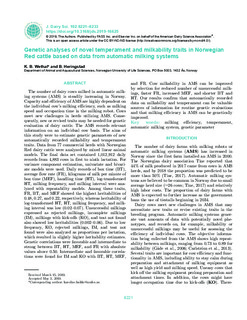| dc.description.abstract | The number of dairy cows milked in automatic milking systems (AMS) is steadily increasing in Norway. Capacity and efficiency of AMS are highly dependent on the individual cow's milking efficiency, such as milking speed and occupation time in the milking robot. Cows meet new challenges in herds utilizing AMS. Consequently, new or revised traits may be needed for genetic evaluation of dairy cattle. The AMS records relevant information on an individual cow basis. The aims of this study were to estimate genetic parameters of new automatically recorded milkability and temperament traits. Data from 77 commercial herds with Norwegian Red dairy cattle were analyzed by mixed linear animal models. The final data set contained 1,012,912 daily records from 4,883 cows in first to ninth lactation. For variance component estimation, univariate and bivariate models were used. Daily records of box time (BT), average flow rate (FR), kilograms of milk per minute of box time (MEF), handling time (HT), log-transformed HT, milking frequency, and milking interval were analyzed with repeatability models. Among these traits, FR, BT, and MEF showed the highest heritabilities of 0.48, 0.27, and 0.22, respectively, whereas heritability of log-transformed HT, HT, milking frequency, and milking interval was low (0.02–0.07). Unsuccessful milkings expressed as rejected milkings, incomplete milkings (IM), milkings with kick-offs (KO), and teat not found also showed low heritabilities (0.002–0.06). Due to low frequency, KO, rejected milkings, IM, and teat not found were also analyzed as proportions per lactation, which resulted in slightly higher heritability estimates. Genetic correlations were favorable and intermediate to strong between BT, HT, MEF, and FR with absolute values above 0.50. Intermediate and favorable correlations were found for IM and KO with BT, HT, MEF, and FR. Cow milkability in AMS can be improved by selection for reduced number of unsuccessful milkings, faster FR, increased MEF, and shorter BT and HT. Our results confirm that automatically recorded data on milkability and temperament can be valuable sources of information for routine genetic evaluations and that milking efficiency in AMS can be genetically improved. | nb_NO |

